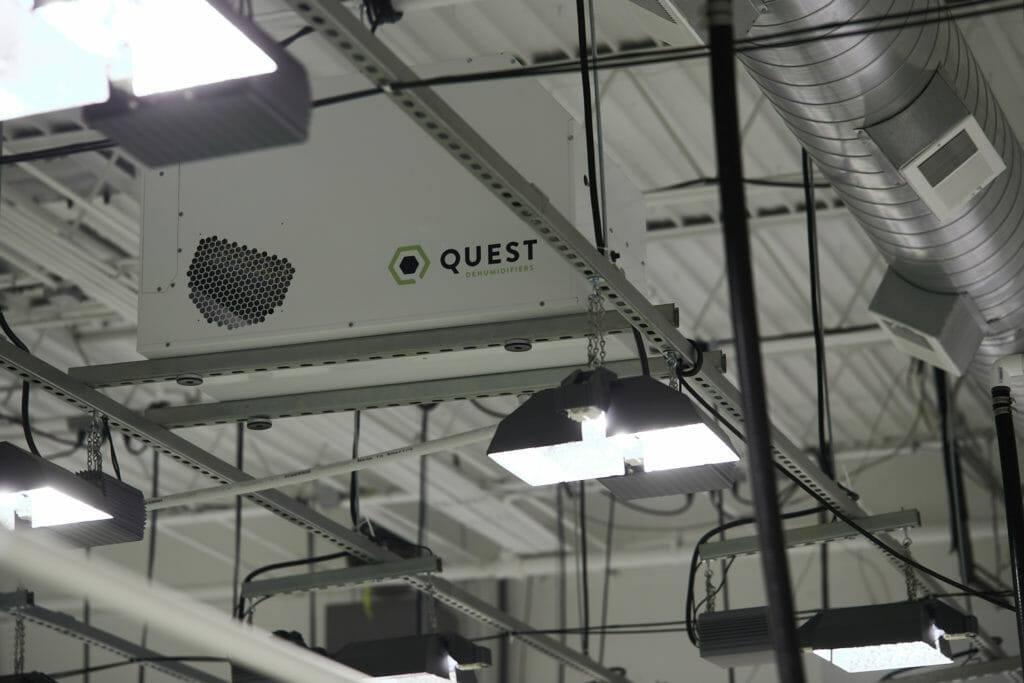The (Un)filtered Truth:
How to Maximize Your Dehumidifiers’ Performance

As cannabis cultivators know, climate control in a grow is a top priority. Also important is filtration in a cannabis grow as well as proper ducting. If not handled properly, both can create common issues for anyone using commercial dehumidifiers. And each can cause a drop in performance, causing costly fluctuations in relative humidity.
Filter Frustration
Here’s the deal. Filters get dirty. That’s not a bad thing. It means they’re doing their job. They’re a critical part of dehumidification. Filters are responsible for removing airborne dirt and particulate, mold spores and pathogens that might otherwise find their way onto plants.
As they capture particulates, something happens inside dehumidifiers: The pressure builds, and air doesn’t flow as easily through the dehumidifier.
That matters because without changing something, your dehumidifier won’t deliver the results you need. Performance will dip and drop off—meaning optimum growing conditions won’t be maintained. So, the verdict? Don’t forget to change your filter!
As a rule of thumb, it’s standard to change filters with every “turn of the room” or after each harvest, using the factory-recommended filter rating. Quest uses MERV 11 to MERV 13 most often.
In turn, this avoids any cross-contamination from one cycle to the next. In addition, cultivators should inspect the filters every two to three weeks to verify they do not need to be changed out more often due to excessive levels of dust in the air.
“Think about a screen on your window. It will be pushed harder and harder if you have a fan blowing hard against it,” said Jerome Verhoeven, an electrical engineer at Quest. “The same goes for filters. As they clog, they become more resistant to airflow.”
Static Stress
The other issue that affects performance: static pressure from ductwork.
In the HVAC world, “external static pressure” refers to any restrictions in the air delivery system that forces the fan to work harder. This restriction could be a filter, a half-closed damper, a bend in the ductwork that causes air to change direction or just the friction of the air rubbing against the ductwork itself. Some of these restrictions, such as the filters, are necessary and beneficial but the overall goal is to reduce external static pressure (ESP) as much as possible for optimal performance.
In many instances, cultivators, facility managers and other operators like to duct their dehumidifiers into a room. As they do, static-pressure increases. This is a result of ducting size, length and number of elbows. This causes a slowdown of air being able to pass through the system. A rule of thumb with Quest units is usually a max of 25 feet of ducting on the supply and return. In addition, a 90-degree elbow can be the equivalent of 5 linear feet of ducting as it contributes to static pressure. Greater static pressures can decrease the performance capacity of the equipment.
How do you avoid or reduce static pressure? ESP reduction is achieved by:
- Using sheet metal duct instead of flex duct
- Reducing the number of elbows
- Installing the shortest runs of ductwork possible
- Keeping the ductwork diameter large to reduce air velocity
- Cleaning the duct system whenever possible.
In addition, it is best to work with a licensed HVAC contractor or mechanical engineer regarding ducting design. There can be substantial calculations as well as specialty tools to measure results.
filtration in cannabis grow
The engineers at Quest have been developing a new approach to help cultivators, facility managers and everyone in between maintain the precise relative humidity levels they expect.
The new Quest solution recognizes changes in pressure and adjusts for more consistent humidity control.
Find out how you can ensure a more consistent grow and be one of the first to learn more about the new product.
Article originally appeared in Cannabis Business Times
Published on Oct 11 2021
Last Updated on Dec 13 2022
Categories: Agriculture, Climate Control, Commercial Dehumidifier, Dehumidification, Growing Cannabis
